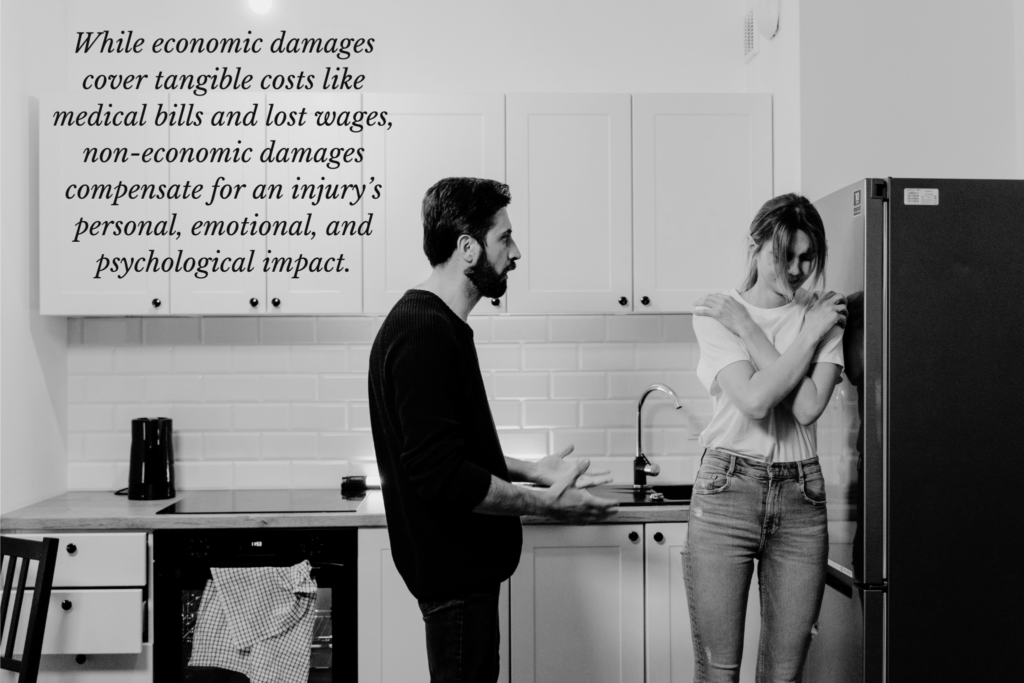When you’re injured in an accident, the financial burden of medical bills and lost wages is just part of the equation. What about the pain you endure daily, the hobbies you can no longer enjoy, or the strain on your relationships? These losses—called non-economic damages—are just as real as financial costs. They include pain and suffering, emotional distress, disfigurement, and loss of companionship. Proving these damages can be challenging, but with the right evidence, accident victims can receive compensation that truly reflects their suffering.
Understanding Non-Economic Damages
When someone is injured due to another party’s negligence, they can seek compensation for economic and non-economic damages. While economic damages cover tangible costs like medical bills and lost wages, non-economic damages compensate for an injury’s personal, emotional, and psychological impact. These damages acknowledge that an accident can affect more than just a victim’s finances—it can permanently change their quality of life.

Types of Non-Economic Damages
- Pain and Suffering – This refers to both the physical pain caused by an injury and the emotional distress that comes with it. Chronic pain, limitations in movement, and long-term discomfort all fall under this category.
- Emotional Distress – Accidents often lead to conditions like anxiety, depression, PTSD, and sleep disturbances. These psychological effects can be debilitating and require ongoing mental health treatment.
- Loss of Enjoyment of Life – Many victims are unable to participate in hobbies, sports, or everyday activities they once loved due to their injuries. This loss can significantly impact their happiness and well-being.
- Loss of Consortium – Serious injuries can change a victim’s relationship with their spouse or family, affecting intimacy, companionship, and overall family dynamics.
- Disfigurement and Disability – Permanent scarring, amputations, or other visible injuries can affect a person’s self-esteem and social interactions, leading to lasting emotional struggles.
Unlike medical bills, these damages don’t come with receipts, making them harder to quantify. However, they can be successfully proven in a personal injury claim with the right approach.
Providing Proof of Non-Economic Damages
Unlike economic damages, which can be proven with medical bills and pay stubs, non-economic damages are harder to quantify. Since they don’t have a clear dollar value, insurance companies and defense attorneys often dispute their validity, arguing that emotional distress or pain is exaggerated or can’t be verified.
Additionally, proving the long-term effects of pain, suffering, or emotional distress can be challenging without concrete evidence. Judges and juries rely on testimony, expert opinions, and supporting documentation to assess the legitimacy of these claims. Without strong proof of non-economic damages, victims risk receiving significantly less compensation than they deserve.
Gathering Evidence to Support Non-Economic Damages
Proving pain and suffering or related harm requires strong evidence that illustrates the full impact of the injury. Several forms of documentation can help substantiate a claim.
Medical Records
One of the most compelling forms of evidence is medical documentation. Doctors’ notes, treatment records, and diagnostic tests can confirm the severity of an injury and its long-term effects.
Expert Testimony
Medical professionals, physical therapists, or mental health counselors can verify that the injury will cause a lasting impact on a victim’s physical and emotional well-being.
Personal Testimonies
A victim’s written or verbal testimony plays a crucial role in proving pain and suffering. Describing the daily pain, emotional struggles, and how life has changed since the accident can make a claim more relatable and persuasive. Testimonies from family members, friends, and co-workers can also help paint a fuller picture of how an injury has altered a victim’s life.
Visual Evidence
Photographs and videos taken over time can illustrate the severity of injuries and the recovery process. A pain journal, where the victim records their physical discomfort, emotional distress, and limitations, can further strengthen the case.
Mental Health Records
If the victim has sought therapy or psychiatric treatment due to the accident, counselor or therapist notes can provide credible proof of emotional distress, PTSD, anxiety, or depression resulting from the injury.
Calculating Non-Economic Damages
Since non-economic damages don’t have a fixed dollar value, courts and insurance companies use different calculation methods to determine compensation. Two of the most common methods include:
1. Multiplier Method
This method calculates non-economic damages by multiplying the victim’s total economic damages (medical bills, lost wages, etc.) by a factor—typically between 1.5 and 5, depending on the severity of the injuries. More severe, life-altering injuries receive higher multipliers. For example, if a victim’s economic damages total $50,000 and a multiplier of 3 is applied, their non-economic damages would be valued at $150,000.
2. Per Diem Method
The per diem approach assigns a daily rate to the victim’s pain and suffering, often based on their lost wages. That rate is then multiplied by the number of days they have suffered and are expected to continue suffering. For instance, if the daily rate is $200 and the victim endures pain for 500 days, they would receive $100,000 in non-economic damages.
The chosen method depends on the case’s specifics and jurisdiction, but both help quantify the intangible impact of an injury.
Maximizing Your Compensation for Pain and Suffering
Suffering an injury in an accident affects more than just your finances—it can impact your physical health, emotional well-being, and overall quality of life. Non-economic damages compensate for these hardships, covering pain and suffering, emotional distress, loss of enjoyment, and more. While proving these damages can be challenging, getting the right legal help can assist you in building a persuasive and effective case.
If you or a loved one has been injured and are struggling to prove non-economic damages, Kane Personal Injury can help. Contact our team today to ensure you receive fair compensation for all the ways your life has been impacted.
